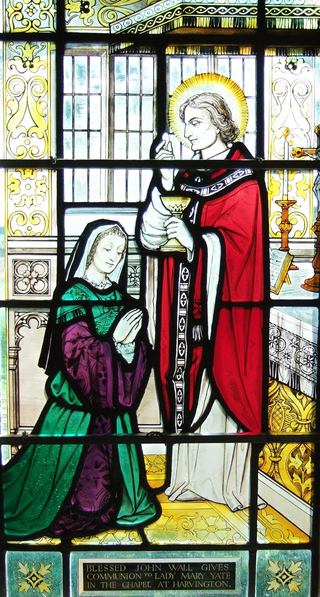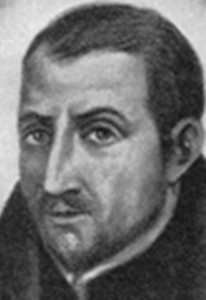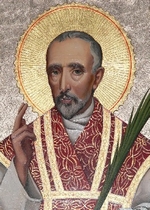Related Research Articles

John Wall,(aliases John Marsh, Francis Johnson or Dormore or Webb, religious name "Joachim of St. Ann") was an English Franciscan friar, who is honoured as a martyr by the Catholic Church. Wall served on the English mission in Worcestershire for twenty-two years before being arrested and executed at the time of Titus Oates's alleged plot.
William Knight was an English layman put to death for his Catholic faith at York, England. With him also suffered George Errington of Herst, Northumberland; William Gibson of Ripon; and Henry Abbot of Howden, Yorkshire.
William Gibson was a layman from Ripon in Yorkshire, England, a member of a noble Scottish family, who was executed at York for professing the Roman Catholic faith. He is honoured as a martyr by the Catholic Church.

Henry Walpole was an English Jesuit martyr, executed at York for refusing to take the Oath of Supremacy.

Edmund Arrowsmith, SJ was one of the Forty Martyrs of England and Wales of the Catholic Church. The main source of information on Arrowsmith is a contemporary account written by an eyewitness and published a short time after his death. This document, conforming to the ancient style of the "Acts of martyrs" includes the story of the execution of another 17th-century recusant martyr, Richard Herst.
George Nichols was an English Catholic martyr.

John Southworth was an English Catholic martyr. He is one of the Forty Martyrs of England and Wales.
Nicholas Garlick was an English Catholic priest, martyred in Derby in the reign of Queen Elizabeth I.

Edward Bamber was an English Roman Catholic priest. He was beatified in 1987.
Edmund Catherick (c. 1605 – 13 April 1642) was an English Roman Catholic priest. He is a Catholic martyr, beatified in 1929.

Edward Morgan was a Welsh Roman Catholic priest and martyr. He was declared venerable by Pope Leo XIII in 1886.

Thomas Whittaker was an English Roman Catholic priest. A Catholic martyr, he was beatified in 1987.
Sydney Hodgson was an English Roman Catholic lawyer, beatified by the Catholic Church as a martyr in 1929.

Thomas Holland was an English Jesuit priest. He is a Catholic martyr, beatified in 1929.
Richard Sergeant (executed at Tyburn, 20 April 1586) was an English Roman Catholic priest. He is a Catholic martyr, beatified in 1987.
Richard Langley was an English Roman Catholic layman, condemned for sheltering Catholic priests. He is a Catholic martyr, beatified in 1929.
James Harrison was an English Roman Catholic priest. He is a Catholic martyr.

William Barrow was an English Jesuit, executed as a result of the fictitious so-called Popish Plot, that between 1678 and 1681 gripped the Kingdoms of England and Scotland in anti-Catholic hysteria. Barrow is regarded as a martyr of the Roman Catholic church and was beatified in 1929.

James Bell was an English Catholic priest and the only one of the Marian Priests that is known to have suffered martyrdom.
During the English Reformation, a number of believers were executed at Lancaster in England as a consequence of their Catholic faith. They are commonly referred to as the Lancaster Martyrs and are commemorated locally by the Lancaster Martyrs Memorial Stone which may be found close to the centre of Lancaster city.
References
- Attribution
 This article incorporates text from a publication now in the public domain : Herbermann, Charles, ed. (1913). "Richard Hurst". Catholic Encyclopedia . New York: Robert Appleton Company. The entry cites:
This article incorporates text from a publication now in the public domain : Herbermann, Charles, ed. (1913). "Richard Hurst". Catholic Encyclopedia . New York: Robert Appleton Company. The entry cites: - Joseph Gillow, Bibl. Dict. Eng. Cath., s.v.;
- ____, Lancashire Recusants, in manuscript;
- Richard Challoner, Memoirs, II (Edinburgh, 1878) 97-101;
- A True and Exact Relation of the Death of Two Catholiks at Lancaster, 1628 (London, 1737), a rare tract;
- Henry Foley in Stonyhurst Magazine No. XX, 112;
- Charles Dodd-Tierney, Cath. Hist.